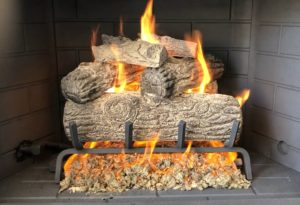Sometimes called “fake logs” or a “gas insert.”These usually consist of a grate, a pan with a burner, sand over the burner, and fake embers on top of the sand. The fake logs, made of something like special concrete or ceramic, then fit on top of the grate. Advantages of gas logs are: Quick start. Quick end of the fire when you’re done. It doesn’t take long to get a fire going, like with a wood fire, and you don’t have to be concerned about a wood fire continuing to burn or smolder long after you want to go to sleep. No smoke. Sometimes with a wood fire, when the wood fire, when the wood fire is just getting started, there might be some smoke spilling out of the fireplace into the room. Then, when the fire is burning well, all the smoke should go up the flue, and not into the room. At the end of the fire, when there is less heat driving gases up the flue, and the fire is smoldering, there again might be smoke spilling out into the room. (Some wood-burning fireplaces have no difficulty expelling the smoke during all three phases of a fire.) Less soot deposited in the upper parts of the system, above the firebox in a space called the “smoke chamber” and above that, in the flue. Some folks can use their gas logs for fires a lot and not have to clean the chimney for years at a time. (Sometimes with gas logs you do get some soot buildup, but it is always less compared to a wood-burning system.) You don’t have to store the wood or carry heavy wood into the house. Disadvantage of a gas-only setup: You don’t get the same sound of the fire burning. No “snap, crackle, pop.” You won’t get any wood burning smell. Probably less heat, but not always true. Some gas log setups put out quite a bit of heat.

